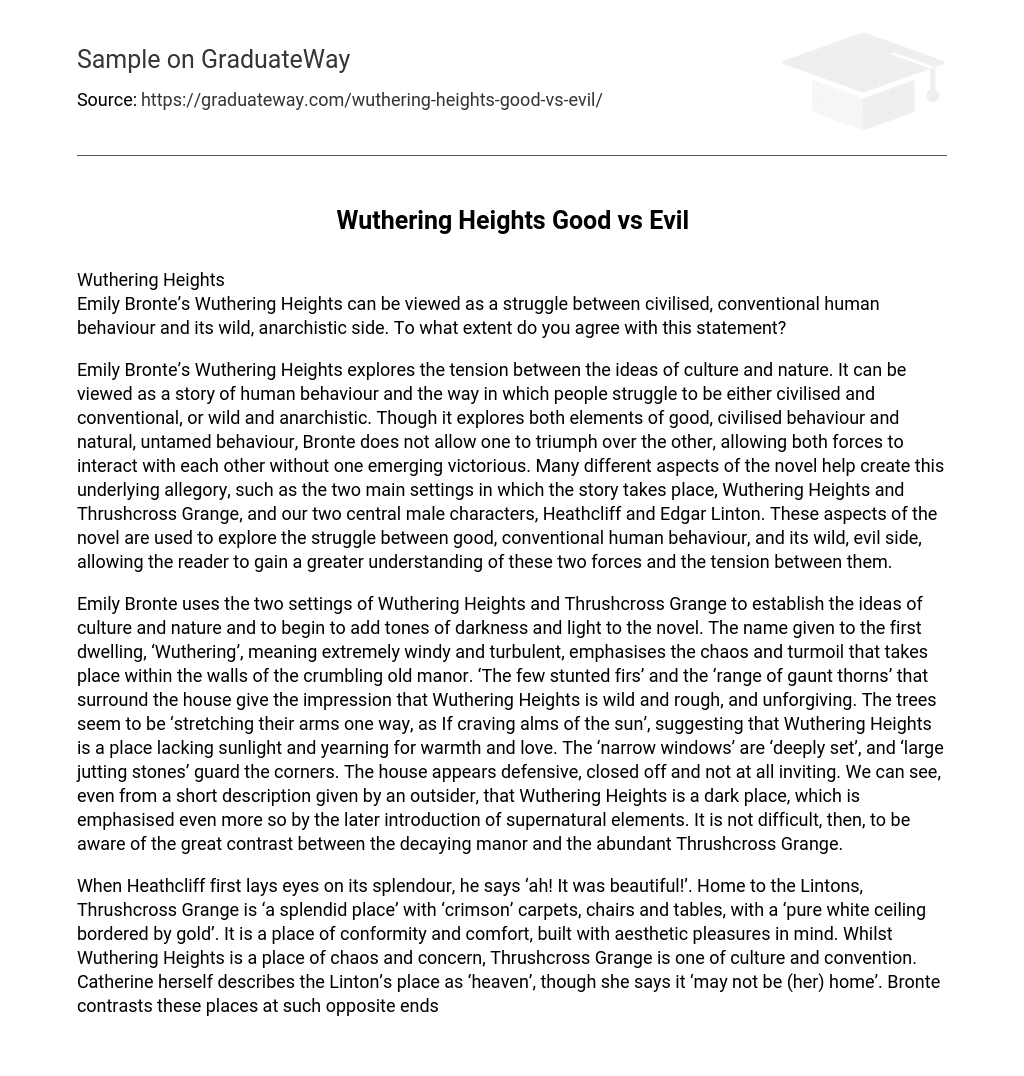Wuthering Heights
Emily Bronte’s Wuthering Heights can be viewed as a struggle between civilised, conventional human behaviour and its wild, anarchistic side. To what extent do you agree with this statement?
Emily Bronte’s Wuthering Heights explores the tension between the ideas of culture and nature. It can be viewed as a story of human behaviour and the way in which people struggle to be either civilised and conventional, or wild and anarchistic. Though it explores both elements of good, civilised behaviour and natural, untamed behaviour, Bronte does not allow one to triumph over the other, allowing both forces to interact with each other without one emerging victorious. Many different aspects of the novel help create this underlying allegory, such as the two main settings in which the story takes place, Wuthering Heights and Thrushcross Grange, and our two central male characters, Heathcliff and Edgar Linton. These aspects of the novel are used to explore the struggle between good, conventional human behaviour, and its wild, evil side, allowing the reader to gain a greater understanding of these two forces and the tension between them.
Emily Bronte uses the two settings of Wuthering Heights and Thrushcross Grange to establish the ideas of culture and nature and to begin to add tones of darkness and light to the novel. The name given to the first dwelling, ‘Wuthering’, meaning extremely windy and turbulent, emphasises the chaos and turmoil that takes place within the walls of the crumbling old manor. ‘The few stunted firs’ and the ‘range of gaunt thorns’ that surround the house give the impression that Wuthering Heights is wild and rough, and unforgiving. The trees seem to be ‘stretching their arms one way, as If craving alms of the sun’, suggesting that Wuthering Heights is a place lacking sunlight and yearning for warmth and love. The ‘narrow windows’ are ‘deeply set’, and ‘large jutting stones’ guard the corners. The house appears defensive, closed off and not at all inviting. We can see, even from a short description given by an outsider, that Wuthering Heights is a dark place, which is emphasised even more so by the later introduction of supernatural elements. It is not difficult, then, to be aware of the great contrast between the decaying manor and the abundant Thrushcross Grange.
When Heathcliff first lays eyes on its splendour, he says ‘ah! It was beautiful!’. Home to the Lintons, Thrushcross Grange is ‘a splendid place’ with ‘crimson’ carpets, chairs and tables, with a ‘pure white ceiling bordered by gold’. It is a place of conformity and comfort, built with aesthetic pleasures in mind. Whilst Wuthering Heights is a place of chaos and concern, Thrushcross Grange is one of culture and convention. Catherine herself describes the Linton’s place as ‘heaven’, though she says it ‘may not be (her) home’. Bronte contrasts these places at such opposite ends of the spectrum, and sets the foundation of the tension and contrast between the two forces of culture and nature to continue throughout the rest of the novel.
The two dwellings, Wuthering Heights and Thrushcross Grange, are set at opposite ends of the spectrum, as are their inhabitants. Heathcliff, a ‘gypsy brat’, ‘dark, almost as if (he) came from the devil’ is at the centre of Wuthering Heights, and so is the focus of the evil that lies within. He is a dark, shadowy character, whose beginnings we are unsure of. He is described as being ‘vindictive’, an outsider in his own home, and an unwelcome misfit in the presence of others, especially the Linton’s. His own wife, Isabella, begs the question, ‘is (Heathcliff) mad? And if not- is he a devil?’. It is quite evident throughout the text that Heathcliff, is symbolic of all things dark and wild. Bronte then characterises our second focal male character as being the complete opposite. Edgar Linton is described by Heathcliff himself as being ‘well dressed and behaved’, ‘handsome’, and ‘rich’. While Heathcliff is ‘dirty’, unruly outcast, Edgar is a fair haired and skinned gentleman. He is everything that his household epitomises; convention and culture. Heathcliff’s character is passionate and powerful, Edgar’s, compassionate, yet weak and uninteresting. Again, Bronte uses contrasting elements to draw attention to the ideas of civil, conventional human behaviour and its wild, anarchistic side.
Wuthering Heights truly is a tale of elements of culture and nature, how they exist in human behaviour, and the way they struggle against each other. Though Wuthering Heights and Heathcliff are the wild and unruly aspects, and Thrushcross Grange and Edgar Linton are the good and civilised aspects, Bronte does not help us to decide which is better or worse. Though some characters are evil and wild, they are shown to be able to feel a deeper love and passion. And, though some characters are seen as good and civilised, their emotions are weak. The Linton’s get pulled into Wuthering Heights and are affected by the chaos, whilst Catherine is pulled into Thrushcross Grange and emerges a civilised ‘lady’. These forces, each affected by one another, demonstrates good being corrupted by evil, and evil being transformed by good. Emily Bronte demonstrates this through her setting and characters in a way that captivates the reader and allows them to decide themselves on the question of culture and nature, and which side, in this particular story, is victorious.





